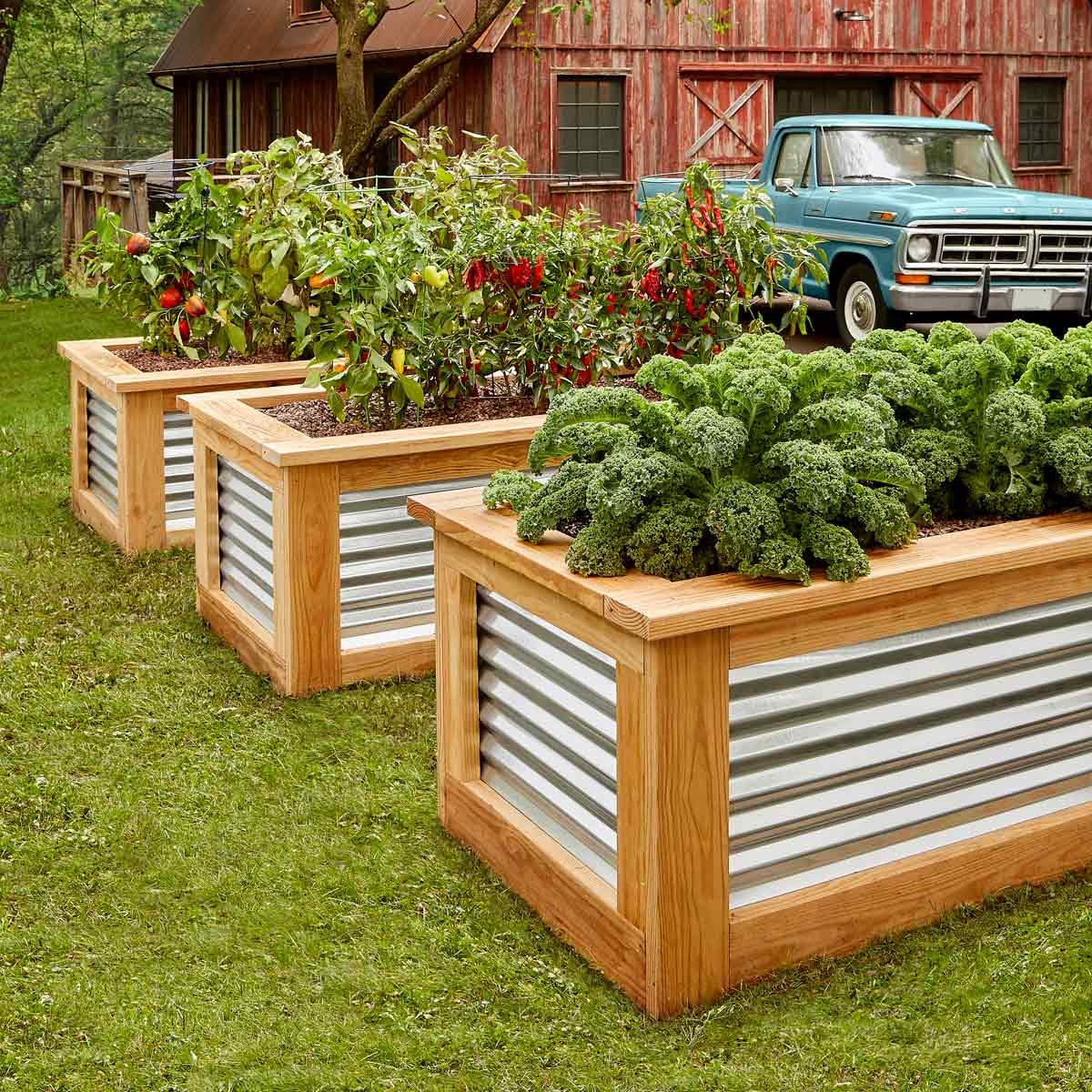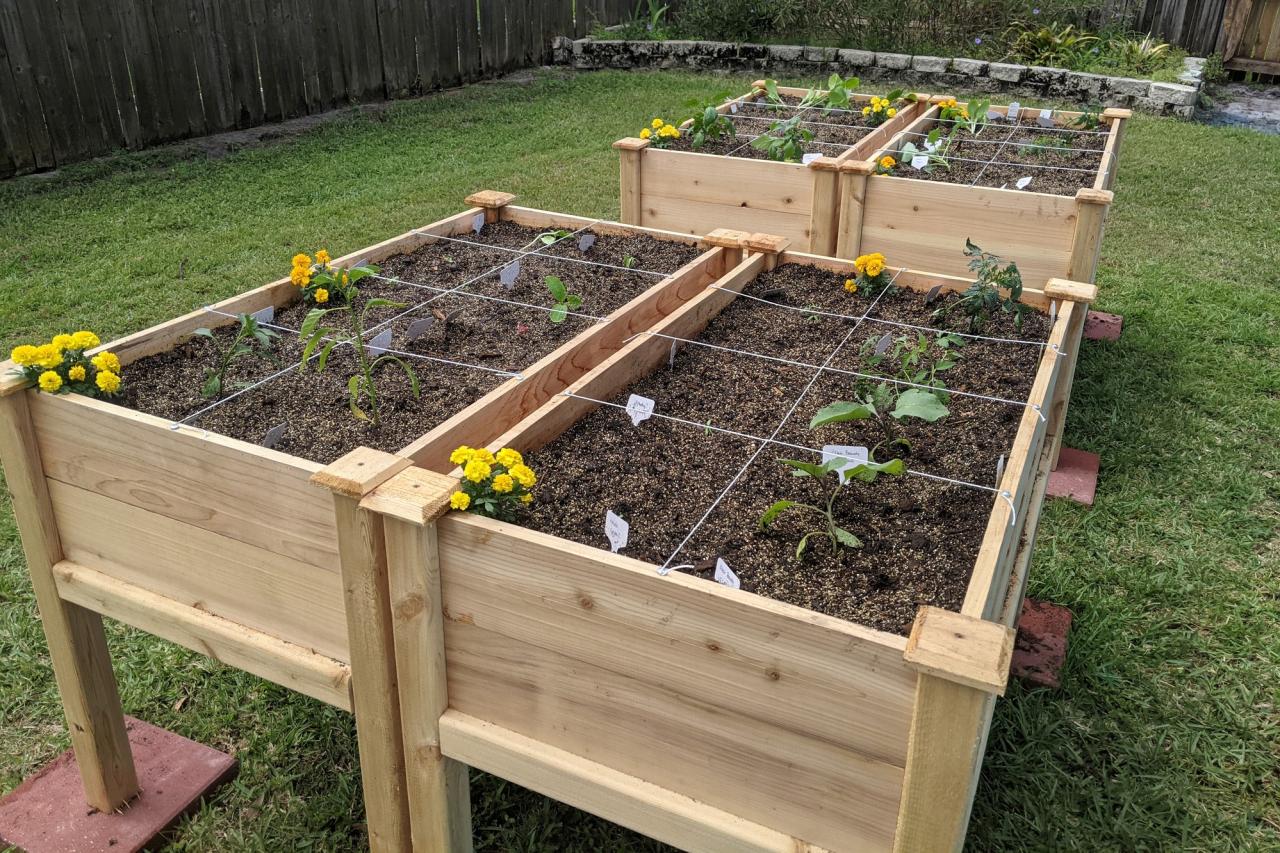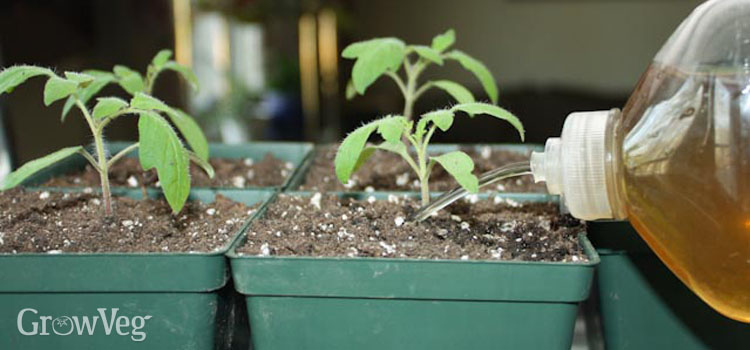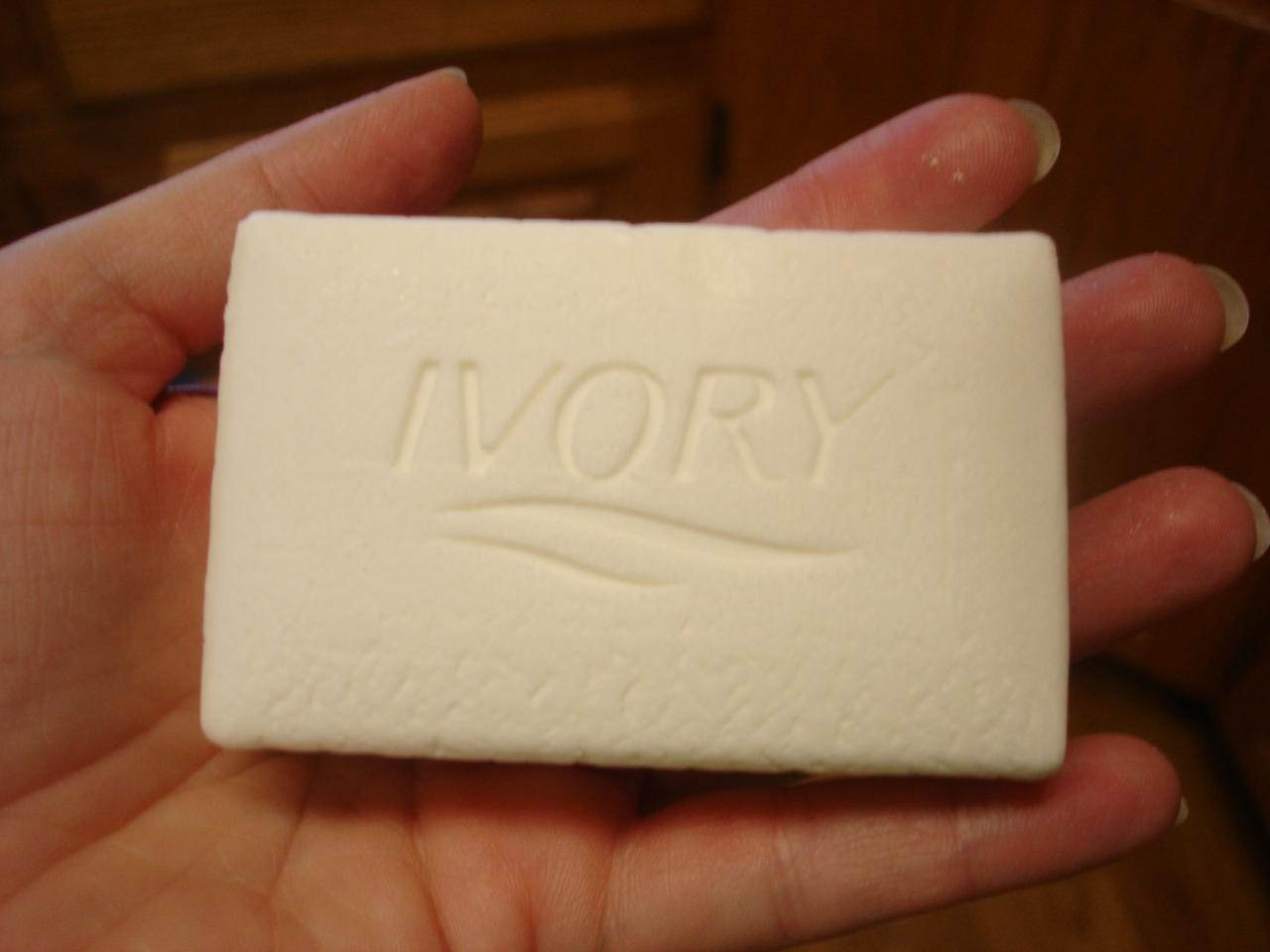DIY raised garden beds set the stage for a rewarding gardening experience, offering a haven for your plants and a beautiful addition to your outdoor space. Unlike traditional gardening, raised beds provide greater control over your soil, making them ideal for gardeners of all levels. From beginners seeking a simplified approach to seasoned green thumbs, the allure of building and cultivating your own raised garden beds is undeniable.
The benefits of DIY raised garden beds extend beyond aesthetic appeal. They offer enhanced drainage, protection from pests, and the ability to customize the growing environment to suit specific plant needs. Whether you’re limited by space, soil quality, or simply desire a more organized and efficient gardening approach, raised beds provide a practical and versatile solution.
Introduction to DIY Raised Garden Beds
Building your own raised garden beds is a rewarding and practical way to enjoy fresh, homegrown produce. Raised garden beds offer numerous benefits over traditional gardening, making them a popular choice for seasoned gardeners and beginners alike.
Benefits of Raised Garden Beds
Raised garden beds provide several advantages, making them an appealing option for many gardeners.
- Improved Drainage: Raised beds allow for better drainage, preventing waterlogging and root rot, especially in areas with heavy clay soil.
- Enhanced Soil Quality: You can easily control the soil composition in raised beds, creating the perfect growing environment for your plants. You can amend the soil with compost, fertilizer, and other beneficial ingredients.
- Pest and Weed Control: Raised beds create a physical barrier against pests and weeds, simplifying maintenance and reducing the need for harsh chemicals.
- Accessibility: Raised beds are ideal for people with limited mobility or back problems, as they provide a comfortable gardening height.
- Flexibility and Control: Raised beds offer flexibility in garden design and allow you to easily experiment with different plant varieties and growing techniques.
Reasons for Choosing DIY Raised Garden Beds
There are several compelling reasons why people choose to build their own raised garden beds instead of using traditional gardening methods.
DIY raised garden beds are a great way to add a touch of green to your home and enjoy fresh produce. If you’re looking for a creative outlet to complement your gardening endeavors, you might want to check out Making Earrings: A Beginners Guide.
Crafting beautiful earrings can be a relaxing and rewarding experience, and you can even use natural materials like wood or stones to tie in with your garden theme. After a day spent tending to your raised beds, crafting some unique earrings can be the perfect way to unwind and express your creativity.
- Cost-Effectiveness: Building your own raised beds can be significantly cheaper than purchasing pre-made ones. You can often source materials from local sources or repurpose existing items.
- Customization: DIY raised beds allow for complete customization. You can design them to fit your space, choose the desired size and shape, and incorporate unique features like built-in seating or water features.
- Personal Satisfaction: The process of building your own raised beds can be very satisfying, providing a sense of accomplishment and ownership.
- Environmental Benefits: DIY raised beds can be constructed using recycled materials, reducing waste and promoting sustainability.
A Brief History of Raised Garden Beds
Raised garden beds have been used for centuries, with evidence dating back to ancient civilizations. Early forms often consisted of mounds of soil or stones, providing better drainage and control over soil conditions. In modern times, raised beds gained popularity in the 19th century, particularly in urban areas where space was limited. The use of wood and other materials allowed for more structured and versatile designs.
Planning Your Raised Garden Bed
Planning is the foundation of any successful garden project, and your raised garden bed is no exception. Careful consideration of factors like size, shape, and location will lay the groundwork for a thriving and enjoyable gardening experience.
Determining the Size and Shape
The size and shape of your raised garden bed will be determined by the types of plants you want to grow, the available space in your yard, and your personal preferences.
- Consider the space you have available. Measure the area where you plan to place your raised garden bed.
- Think about the types of plants you want to grow. For example, if you want to grow tall vegetables like tomatoes or beans, you will need a taller bed. If you are growing herbs or smaller vegetables, a shorter bed will suffice.
- Choose a shape that suits your space and gardening style. Square, rectangular, and circular beds are all popular options.
Choosing the Right Location
The location of your raised garden bed is crucial for its success.
- Sunlight is essential for plant growth. Choose a location that receives at least 6 hours of direct sunlight each day.
- Accessibility is important. Make sure you can easily reach all parts of your raised garden bed for planting, weeding, and harvesting.
- Consider the soil type. Raised garden beds can be used to improve soil conditions, but it’s still a good idea to choose a location with well-drained soil.
Raised Garden Bed Design Examples
There are countless creative and functional raised garden bed designs.
- Traditional rectangular raised beds are simple to build and versatile.
- L-shaped raised beds are a space-saving option that can fit into corners of your yard.
- Circular raised beds offer a unique aesthetic and can be a great option for smaller gardens.
- Vertical raised beds are perfect for small spaces or for growing vining plants.
Materials for DIY Raised Garden Beds
Choosing the right materials for your raised garden bed is crucial for its durability, aesthetics, and functionality. Consider factors like your budget, the style you desire, and the climate in your area.
Wood
Wood is a popular choice for raised garden beds due to its affordability, versatility, and natural beauty.
- Pros: Wood is readily available, easy to work with, and can be stained or painted to match your garden’s aesthetic. It’s also a good insulator, which helps regulate soil temperature.
- Cons: Wood is susceptible to rot and decay, especially when exposed to moisture. It also requires regular maintenance, such as staining or sealing, to extend its lifespan.
To ensure durability, use pressure-treated lumber or cedar, which are naturally resistant to rot and decay. Also, consider using a wood sealant or paint to further protect the wood from the elements.
Concrete
Concrete is a durable and long-lasting material for raised garden beds.
- Pros: Concrete is resistant to rot, decay, and pests. It’s also relatively low-maintenance and can withstand harsh weather conditions.
- Cons: Concrete can be expensive and difficult to work with. It can also be heavy, making it challenging to move or relocate the garden bed.
If you choose concrete, consider using pre-made concrete blocks or molds for easier construction.
Metal, Diy raised garden beds
Metal is a durable and modern option for raised garden beds.
- Pros: Metal is resistant to rot, decay, and pests. It’s also relatively low-maintenance and can withstand harsh weather conditions.
- Cons: Metal can be expensive, especially for larger garden beds. It can also heat up in direct sunlight, potentially affecting soil temperature.
When choosing metal, consider galvanized steel or aluminum, which are resistant to rust and corrosion.
Construction Techniques

Now that you have a plan and materials, it’s time to get your hands dirty and build your raised garden bed. There are several construction techniques, each with its own advantages and disadvantages. Let’s explore the most common methods.
Building a Raised Garden Bed from Wood
Building a raised garden bed from wood is a popular choice due to its affordability and ease of construction. Here’s a step-by-step guide:
- Cut the wood to size. You will need four long pieces for the sides and four short pieces for the ends. Make sure all the pieces are cut to the same length.
- Assemble the frame. Join the pieces together using screws or nails. You can use corner brackets for extra stability.
- Attach the bottom. Cut pieces of plywood or other suitable material to fit the bottom of the frame. Secure them in place with screws or nails.
- Add a layer of landscape fabric. This will help prevent weeds from growing into your garden bed.
- Fill the bed with soil. Use a high-quality potting mix or garden soil.
Soil Preparation and Planting
You’ve carefully designed and built your raised garden bed, but the real magic happens with the soil. Choosing the right soil and preparing it properly will give your plants the best chance to thrive.
Soil Selection
The soil you use in your raised garden bed is crucial for plant growth. It needs to provide adequate drainage, aeration, and nutrients. Avoid using soil directly from your yard, as it may contain pests, diseases, or compacted clay. Instead, opt for a high-quality potting mix specifically designed for raised beds or gardens. Look for mixes that contain a blend of peat moss, compost, and other organic matter.
Soil Preparation
Once you have your soil, it’s time to prepare it for planting. Here’s a step-by-step guide:
1. Remove debris: Before adding any soil, clear the bed of any debris, such as leaves, twigs, or rocks.
2. Add a layer of compost: Compost is a rich source of nutrients and helps improve soil structure. Spread a layer of compost at least 4-6 inches deep in the bottom of your raised bed.
3. Mix in soil amendments: To further enhance your soil, consider adding other amendments like aged manure, worm castings, or bone meal. These amendments will provide essential nutrients for your plants.
4. Water thoroughly: Once you’ve added your soil and amendments, water the bed thoroughly to help settle the soil and allow it to absorb the moisture.
Benefits of Compost and Amendments
Compost and other soil amendments provide numerous benefits for your raised garden bed:
* Improved drainage and aeration: Compost helps create air pockets in the soil, allowing roots to breathe and water to drain properly.
* Increased nutrient content: Compost is rich in essential nutrients like nitrogen, phosphorus, and potassium, which are vital for plant growth.
* Improved soil structure: Compost helps bind soil particles together, creating a more stable and fertile growing medium.
* Suppression of diseases and pests: Compost introduces beneficial microorganisms that can help suppress harmful diseases and pests.
Watering and Maintenance
Proper watering and regular maintenance are essential for the health and productivity of your raised garden beds. By following the right techniques and practices, you can ensure your plants thrive and your garden remains vibrant.
Watering Techniques
Watering your raised garden bed effectively is crucial for plant growth.
- Deep watering is preferred over frequent shallow watering. This encourages roots to grow deep into the soil, making plants more resilient to drought.
- Water in the morning to allow the soil to dry slightly before nightfall, reducing the risk of fungal diseases.
- Use a watering can with a rose to distribute water evenly and avoid soil erosion.
- Check soil moisture regularly by inserting your finger into the soil. If it feels dry an inch below the surface, it’s time to water.
Preventing Overwatering and Underwatering
- Overwatering can lead to root rot and fungal diseases. Signs of overwatering include wilting leaves, yellowing foliage, and a musty smell from the soil.
- Underwatering can cause plants to wilt and struggle to grow. Look for signs of dry soil, drooping leaves, and browning leaf tips.
- Use a moisture meter to accurately measure soil moisture levels.
- Mulch around plants to help retain moisture and suppress weeds.
Maintenance Tasks
Regular maintenance is key to a healthy and productive garden.
- Weeding is essential to prevent weeds from competing with your plants for nutrients and water.
- Pest control is important to protect your plants from insects and diseases.
- Fertilizing is necessary to replenish nutrients in the soil, especially after harvesting.
- Pruning can help shape plants, improve air circulation, and encourage new growth.
Weeding
Weeds compete with your plants for resources, hindering their growth.
- Hand weeding is effective for small gardens and can be done regularly to prevent weeds from taking root.
- Mulching can suppress weed growth by blocking sunlight and preventing seeds from germinating.
- Using a hoe to cultivate the soil surface can help control weeds by uprooting them.
Pest Control
Pests can damage plants and reduce yields.
- Identify the pest to determine the best control method.
- Use organic methods like insecticidal soap, neem oil, or diatomaceous earth whenever possible.
- Introduce beneficial insects like ladybugs or lacewings to naturally control pest populations.
- Monitor plants regularly for signs of pests and take action promptly.
Choosing the Right Plants
Selecting the right plants for your raised garden bed is crucial for successful gardening. Consider the bed’s location, size, and your personal preferences when making your choices.
Plant Preferences and Growing Conditions
The ideal plants for your raised garden bed depend on several factors:
- Sunlight: Determine the amount of sunlight your garden bed receives daily. Sun-loving plants like tomatoes, peppers, and herbs require at least six hours of direct sunlight, while shade-tolerant plants like lettuce, spinach, and kale thrive in partial shade.
- Soil Type: Raised garden beds provide a controlled environment for growing plants. You can select a soil mix that meets the specific needs of your chosen plants. For example, a well-draining mix is suitable for vegetables, while a richer, more moisture-retentive mix is ideal for flowers.
- Climate: Consider your local climate when selecting plants. Choose varieties that are well-suited to your region’s temperature and rainfall patterns.
Popular Plants for Raised Garden Beds
- Vegetables: Tomatoes, peppers, cucumbers, zucchini, beans, carrots, lettuce, spinach, kale, and herbs like basil, oregano, and thyme are all excellent choices for raised garden beds.
- Flowers: Marigolds, zinnias, petunias, sunflowers, and lavender are known for their beauty and ability to thrive in raised garden beds.
- Fruits: Strawberries, blueberries, and raspberries can also be successfully grown in raised garden beds.
Spacing Plants for Optimal Growth
Spacing plants correctly is essential for healthy growth and maximized yields.
- Spacing Guide: Refer to seed packets or plant labels for recommended spacing guidelines.
- Benefits of Proper Spacing: Adequate spacing allows for proper airflow, sunlight penetration, and root development, minimizing disease and pest problems.
Creative Design Ideas

Beyond the functional aspects of raised garden beds, there’s a world of creative design options to enhance their aesthetic appeal and seamlessly integrate them into your outdoor space. From vertical gardens that maximize space to tiered beds that add visual interest, the possibilities are limited only by your imagination.
Vertical Gardens
Vertical gardens are a space-saving solution for urban gardeners or those with limited yard space. They are an excellent way to add greenery to walls, fences, or even balconies.
- Pallet Gardens: Repurposed pallets can be transformed into vertical garden structures by creating individual planting pockets or using wire mesh to hold soil.
- Living Walls: These systems typically use modular panels with integrated pockets for planting, creating a seamless, vertical green wall.
- Trellis Gardens: Vines and climbing plants can be trained to grow vertically on a trellis, creating a beautiful and functional green wall.
Tiered Beds
Tiered garden beds, also known as stacked beds, create a multi-level gardening experience. They add visual interest and allow you to grow a wider variety of plants with different sun and water requirements.
- Stacked Stone Beds: Use natural stone to build tiers, creating a rustic and charming look.
- Wooden Tiered Beds: Wooden planks or pallets can be used to construct tiered beds, providing a more contemporary look.
- Concrete Tiered Beds: Concrete offers a durable and long-lasting option for tiered beds, suitable for modern or minimalist gardens.
Decorative Elements
Adding decorative elements to your raised garden beds can enhance their visual appeal and personalize your garden.
- Trellises: Trellises provide support for climbing plants and can add vertical interest to your garden. They can be made from various materials like wood, metal, or bamboo, and come in different styles.
- Edging: Edging materials define the perimeter of your raised garden beds and create a clean and polished look. Options include bricks, stone, wood, or even metal.
- Decorative Stones: Stones can be used to create pathways around your raised garden beds or to add decorative accents to the beds themselves.
- Sculptures and Statues: Adding sculptures or statues can add a unique touch to your garden and create focal points.
Integrating Raised Garden Beds
Raised garden beds can be seamlessly integrated into existing landscaping, enhancing the overall design.
- Matching Materials: Choose materials for your raised garden beds that complement the existing landscaping, such as using stone if your patio or walkway is made of stone.
- Planting Schemes: Plant flowers and shrubs around your raised garden beds that complement the plants growing inside, creating a cohesive look.
- Pathways and Walkways: Create pathways or walkways that lead to your raised garden beds, inviting visitors to explore your garden.
Troubleshooting Common Issues: Diy Raised Garden Beds
Even the most well-designed raised garden bed can encounter problems. This section addresses common issues and provides solutions to help you maintain a healthy and productive garden.
Drainage Problems
Proper drainage is crucial for preventing root rot and other plant diseases. If your raised garden bed doesn’t drain well, water can accumulate, creating an environment where harmful bacteria and fungi thrive.
- Check for drainage holes: Ensure your raised garden bed has adequate drainage holes at the bottom. These holes allow excess water to escape, preventing waterlogging.
- Raise the bed: If your raised garden bed is sitting on compacted soil, consider raising it slightly to improve drainage. This can be achieved by adding blocks or bricks beneath the bed.
- Amend the soil: Adding amendments like compost or sand to your soil can improve drainage. These materials increase the soil’s porosity, allowing water to flow through more easily.
Pest Control
Pests can be a nuisance in any garden, and raised beds are no exception. Common pests include slugs, snails, aphids, and whiteflies.
- Physical barriers: Copper tape or diatomaceous earth can be used to deter slugs and snails. These materials create a barrier that they find unpleasant to cross.
- Beneficial insects: Introducing beneficial insects like ladybugs and lacewings can help control pest populations. These insects prey on aphids and other harmful pests.
- Organic pesticides: Organic pesticides, such as neem oil or insecticidal soap, can be used to control pests without harming beneficial insects.
Disease Prevention
Diseases can also affect plants in raised beds. Common diseases include powdery mildew, blight, and rust.
- Choose disease-resistant varieties: Selecting plant varieties known for their disease resistance can significantly reduce the risk of infection.
- Proper spacing: Ensure adequate spacing between plants to promote airflow and prevent disease spread.
- Avoid overhead watering: Water at the base of plants to minimize the risk of spreading fungal diseases.
Maintaining Structural Integrity
Over time, the wood or other materials used to construct your raised garden bed can deteriorate, compromising its structural integrity.
- Regular inspection: Inspect your raised garden bed regularly for signs of rot, cracks, or damage.
- Repairs and maintenance: Address any damage promptly to prevent further deterioration. This may involve replacing damaged boards, reinforcing weak areas, or applying a protective sealant.
- Material selection: Choose durable materials like cedar or redwood, which are naturally resistant to rot and decay.
Ultimate Conclusion
Creating your own raised garden beds is an empowering journey that blends creativity with practicality. From selecting the perfect materials and designing your dream layout to nurturing your plants and harvesting the fruits (or vegetables) of your labor, the process is as rewarding as the results. As you delve into the world of DIY raised garden beds, remember that the possibilities are endless, and the satisfaction of cultivating your own edible oasis is truly fulfilling.


